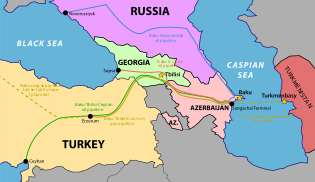Sangachal Terminal
The Sangachal Terminal is an industrial complex consisting of a natural gas processing plant and oil production plant, located on the coast of the Caspian Sea 45 kilometres (28 mi) south of Baku, Azerbaijan.
| Sangachal Terminal | |
|---|---|
.jpg) | |
| Location | |
| Country | Azerbaijan |
| Location | Sangachal |
| Coordinates | 40.201262°N 49.481270°E |
| Details | |
| Opened | 1996 |
| Operated by | BP |
| Owned by | Azerbaijan Republic |
| Type of harbor | Oil and Gas Terminal |
| Size | 500 hectares |
| Statistics | |
| Annual cargo tonnage | 3 million barrels (480×103 m3) |
History
Construction of the terminal began in 1996 with the Early Oil Project, which foresaw construction of pipelines to Supsa and Novorossiysk. Oil was first exported in October 1997. The terminal has since been expanded to include the ACG Phase 1, Phase 2, Phase 3 Oil Trains, BTC's main pumping station and the Shah Deniz gas plant. Facilities at the oil production plant include separators, coalescers, three new crude oil storage tanks, Export Pumps, gas turbine power generators and a central control room.[1]
Sangachal Terminal Expansion Program
The Sangachal Terminal Expansion Program (STEP) was started in November 2001. The construction included 15,000 cubic metre of concrete, 1,600 units of steel structures, 25,000 metres (82,000 ft) of pipe, 450,000 metres (1,480,000 ft) of cables. Apart from technological works, civil construction included living accommodations for 550 people, cafeteria, movie theater, soccer field, etc. US$1.2-2 billion was spent for sub-projects realized within the STEP project.[2][3]

The terminal expansion contract was awarded to Tekfen-Azfen joint venture[4] which employed nearly 4,000 employees for the project, 75% of which were Azerbaijani citizens. Due to finalization of the main part of the project, this number was reduced to 1,720 employees.[2]
Technical features
Sangachal Terminal has a processing capacity of 1.2 million barrels per day (190×103 m3/d) and 1.25 billion cubic feet (35×106 m3) of gas per day (bcfd). The three new crude oil storage tanks added during the STEP have a capacity of 880 thousand barrels (140×103 m3) each.[5] The overall storage capacity at the terminal is 3 million barrels (480×103 m3).[6] As of November 2009, the terminal exports 941.4 thousand barrels per day (149.67×103 m3/d).[7]
The terminal is operated by a BP led consortium and is one of the largest oil and gas facilities in the world.[8] Other partners are from AIOC, Baku-Tbilisi-Ceyhan pipeline, Shah Deniz and South Caucasus Pipeline projects. The terminal receives oil from the Azeri-Chirag-Guneshli field and natural gas from the Shah Deniz gas field.
The oil is exported via the Baku-Tbilisi-Ceyhan pipeline to Turkey's Mediterranean coast and via the Baku-Supsa Pipeline and the Baku-Novorossiysk Pipeline to the Black Sea coast.[9] Sangachal Terminal was mentioned in documents published by WikiLeaks as one of US "critical foreign dependencies".[10]
See also
- Azeri-Chirag-Guneshli
- Natural gas processing
- Natural gas condensate
- Oil production plant
References
- "BP Begins Production at West Azeri Field in the Caspian Sea". Rigzone. 2006-01-05. Retrieved 2010-01-26.
- Nurlana Guliyeva (2008-01-23). "Энергоцентр Каспийского региона" [Energy hub of the Caspian region]. Izvestiya. Retrieved 2010-01-26.
- Aleksandr Panich. "Диверсификация энергоисточников" [Diversification of Energy sources]. Atlas Invest. Retrieved 2010-01-26.
- "BTC Company formed, first pipeline construction contracts awarded". 7 (16). Alexander's Gas & Oil Connections. 2002-08-23. Retrieved 2010-01-26.
- BP Caspian – Overview
- Terminal – present BP Caspian. Sangachal Terminal – present
- "Sangachal Terminal exports more than 941 400 barrels of oil per day". APA. 2009-11-23. Archived from the original on 2012-02-25. Retrieved 2010-01-26.
- Ivan Watson (2006-04-18). "With New Pipeline, Azerbaijan on Verge of Oil Boom". NPR. Retrieved 2010-01-26.
- U.S. Energy Information Administration. Azerbaijan. Natural Gas Archived 2010-01-09 at the Wayback Machine
- Cable Viewer Archived 2010-12-24 at the Wayback Machine